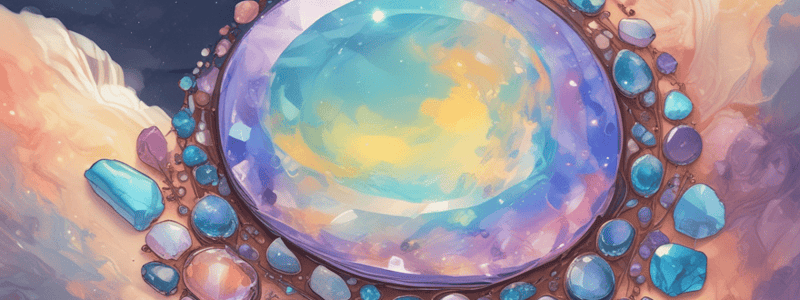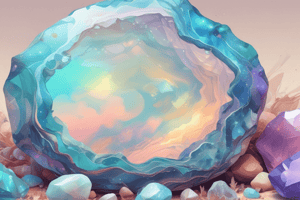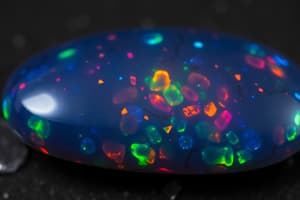Podcast
Questions and Answers
What is the primary characteristic that distinguishes precious opal from common opal?
What is the primary characteristic that distinguishes precious opal from common opal?
- Mohs scale rating
- Background color
- Presence of impurities within opal's silica spheres
- Play of color (correct)
Which type of opal is considered the most valuable and typically sold by the piece?
Which type of opal is considered the most valuable and typically sold by the piece?
- Semi-black opal
- Black crystal opal
- Black opal (correct)
- Gray-base black opal
What is the primary factor that determines the transparency or opacity of opal?
What is the primary factor that determines the transparency or opacity of opal?
- Type of impurities present
- Number of silica spheres
- Number of impurities within opal's silica spheres (correct)
- Presence of play of color
Which of the following is NOT a characteristic of white opal?
Which of the following is NOT a characteristic of white opal?
What is the typical background color of semi-black opal?
What is the typical background color of semi-black opal?
Which of the following is a characteristic of black crystal opal?
Which of the following is a characteristic of black crystal opal?
What is the purpose of assembling opal layers with other materials?
What is the purpose of assembling opal layers with other materials?
What is the characteristic of a triplet opal?
What is the characteristic of a triplet opal?
What is the chemical composition of opal?
What is the chemical composition of opal?
According to the weathering theory, how is opal formed?
According to the weathering theory, how is opal formed?
What is the characteristic of gem-quality non-phenomenal opal?
What is the characteristic of gem-quality non-phenomenal opal?
What is the characteristic of opal that gives it a picturesque agate-like appearance?
What is the characteristic of opal that gives it a picturesque agate-like appearance?
What is the primary factor that determines the hue of play-of-color in pink opal?
What is the primary factor that determines the hue of play-of-color in pink opal?
What is the term used to describe the vividness of an opal's play-of-color?
What is the term used to describe the vividness of an opal's play-of-color?
What is the most valuable type of opal pattern?
What is the most valuable type of opal pattern?
What is the characteristic of an opal that can indicate a lack of stability?
What is the characteristic of an opal that can indicate a lack of stability?
What is the requirement for an opal to undergo common treatments such as sugar treatment or smoke treatment?
What is the requirement for an opal to undergo common treatments such as sugar treatment or smoke treatment?
What is the term used to describe the network of cracks that can appear on an opal when it dries out?
What is the term used to describe the network of cracks that can appear on an opal when it dries out?
What is the name of the opal imitation made of glass, which has a similar appearance to play-of-color, caused by tinsel-like flakes?
What is the name of the opal imitation made of glass, which has a similar appearance to play-of-color, caused by tinsel-like flakes?
In which country was plastic imitation opal first marketed in the late 1980s?
In which country was plastic imitation opal first marketed in the late 1980s?
What is the primary goal of a cutter when cutting opals?
What is the primary goal of a cutter when cutting opals?
Which city in India is one of the main fashioning hubs for Ethiopian opal as well as fire opal from Mexico?
Which city in India is one of the main fashioning hubs for Ethiopian opal as well as fire opal from Mexico?
What is the purpose of fracture filling in opals?
What is the purpose of fracture filling in opals?
What is the name of the synthetic opal manufactured using chemical precipitation, which has a structural pattern resembling honeycomb or snake skin under magnification?
What is the name of the synthetic opal manufactured using chemical precipitation, which has a structural pattern resembling honeycomb or snake skin under magnification?
Which country was a major cutting hub for opal, but has been replaced by other countries such as India, Vietnam, and Thailand due to economic reasons?
Which country was a major cutting hub for opal, but has been replaced by other countries such as India, Vietnam, and Thailand due to economic reasons?
What is the typical shape of commercial quality opals?
What is the typical shape of commercial quality opals?
During the 1980s-1990s, which country's consumers were the top buyers of opal?
During the 1980s-1990s, which country's consumers were the top buyers of opal?
Which of the following countries is NOT a significant source of opals?
Which of the following countries is NOT a significant source of opals?
What is the purpose of coating opals with resin or plastic?
What is the purpose of coating opals with resin or plastic?
What is the term for opals that have been filled with melted wax, resin, polymer, or plastic?
What is the term for opals that have been filled with melted wax, resin, polymer, or plastic?
What is the color/hue range for black crystal opal ?
What is the color/hue range for black crystal opal ?
What are trade names for Opal?
What are trade names for Opal?
Flashcards are hidden until you start studying
Study Notes
Opal Basics
- The largest consumers of opal are the Americans, followed by Europe and China, along with other Southeast Asian countries like India.
- Opal has a Mohs hardness of 5 to 7.
Types of Opal
- Precious Opal: Has a play of color, also known as "phenomenal" opal.
- Common Opal: Does not have a play of color, also known as "potch opal".
- Black Opal: Has a dark background, typically the most valuable type, and is usually sold by the piece.
- Semi-black Opal: Has a grayish background, translucent to opaque.
- Black Crystal Opal: Has a dark background, transparent to semitransparent.
- Gray-base Black Opal: Has a gray background, opaque when held up to light.
- White Opal: Has a white or medium gray background, shows play of color.
- Assembled Opal: Layers of precious opal and other material, cemented together to improve durability and appearance.
Color and Hue
- Background Color: Caused by impurities within opal's silica spheres, affects transparency and value.
- Play of Color: Determines the value of an opal, with red being the most preferred hue.
- Multicolors: Play of color consists of one main color and two or more secondary colors.
Patterns and Clarity
- Pattern: The arrangement of an opal's play of color, with industry categories including Pinfire, Flash, and Harlequin.
- Clarity: Opaque to transparent, with value varying depending on type, and cloudiness or milkiness lowering the value.
Chemical Composition and Forming Source
- Chemical Composition: Hydrous silica (SiO2·nH2O), consisting of silicon and oxygen.
- Forming Source: Sedimentary and volcanic rocks, with four recognized theories: weathering, microbe, syntectonic, and redox.
Crystal Structure and Possible Phenomena
- Crystal Structure: No overall crystal structure, but instead a three-dimensional arrangement of uniform, submicroscopic silica spheres.
- Possible Phenomena: Play of color, with the size of the spheres determining the hue displayed.
Treatments and Imitations
- Common Treatments: Sugar, smoke, impregnation, dying, fracture filling, coating.
- Imitation Materials: Slocum Stone, plastic imitation opal, "Opalite", and "Opal Essence".
Cutting and Trading Centers
- Cutting and Trading Centers: Santiago de Querétaro, Mexico, and Jaipur, India, are major centers for opal cutting and trading.
- Historical Trading Hubs: China, Japan, India, Vietnam, and Thailand have been used as cutting and trading hubs.
Other Opal Facts
- Countries of Origin: Australia, Ethiopia, and Mexico are the largest suppliers of opal, with other locations including Brazil, the US, Canada, Honduras, Peru, Madagascar, Slovakia, and Austria.
- Fire Opal: Often found in Mexico, Honduras, and the southwestern United States.
- Trade Names: "Pandora", "Light of the World", and "Empress" are trade names for opal.
Studying That Suits You
Use AI to generate personalized quizzes and flashcards to suit your learning preferences.




